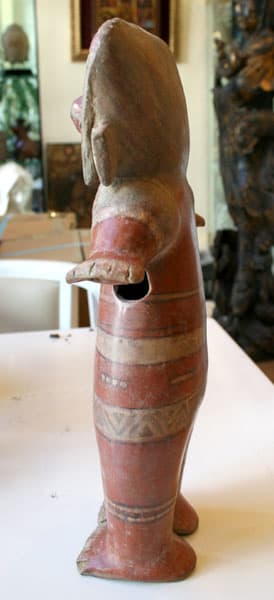Chorrera Terracotta Figure, 1100 BCE - 300 BCE
7 x 14
CK.0803
Further images
The Pre-Columbian cultures of Ecuador are among the oldest in South America and among the first to master the art of pottery. Although we know little about the peoples themselves...
The Pre-Columbian cultures of Ecuador are among the oldest in South America and among the first to master the art of pottery. Although we know little about the peoples themselves or their traditions, historians have been able to piece together a picture of life in Ancient Ecuador thanks in part to the art and artifacts left behind. The culture of Valdivia created some of the oldest known works of art in the Americas. Situated along the coastal strip of Ecuador, the Valdivians established a thriving society that flourished for around two thousand years (from approximately 4000 to 1500 B.C.). Today they are famed for their small fertility figures, believed to be the earliest representational works of art in the Americas, first carved from stone, later formed from terracotta.
Hundreds of years later after the Valdivians disappear from the archaeological record appears another culture to which the name Chorrera has been attached (lasting from circa 1100-300 B.C.). Little is known about this culture; however, it is significant for its widespread geographical reach. As such, their artistic style greatly influenced those diverse cultures that began to emerge in the final centuries of the Chorrera period, a time historians have labeled the Period of Regional Development.
This figure from the Chorrera period (Contemporary with the Chavin of Peru and the Tlatilco in Mexico) reveals the Ecuadorian craftsmen's incredible skill at manipulating the medium and his creative ability to elevate the workaday life of the Ancient Ecuadorian to grand and noble heights. Here we experience a standing figure captured in a moment of suspended motion, arms ready to vigorously stir the contents of a large bowl. The figure's resolute facial expression further enhances the spirit of piece, dignifying an action of relative simplicity. How extraordinary indeed is the creative expression of the Ancient Ecuadorian artist who crafted this powerful work of ceramic art.
Hundreds of years later after the Valdivians disappear from the archaeological record appears another culture to which the name Chorrera has been attached (lasting from circa 1100-300 B.C.). Little is known about this culture; however, it is significant for its widespread geographical reach. As such, their artistic style greatly influenced those diverse cultures that began to emerge in the final centuries of the Chorrera period, a time historians have labeled the Period of Regional Development.
This figure from the Chorrera period (Contemporary with the Chavin of Peru and the Tlatilco in Mexico) reveals the Ecuadorian craftsmen's incredible skill at manipulating the medium and his creative ability to elevate the workaday life of the Ancient Ecuadorian to grand and noble heights. Here we experience a standing figure captured in a moment of suspended motion, arms ready to vigorously stir the contents of a large bowl. The figure's resolute facial expression further enhances the spirit of piece, dignifying an action of relative simplicity. How extraordinary indeed is the creative expression of the Ancient Ecuadorian artist who crafted this powerful work of ceramic art.





